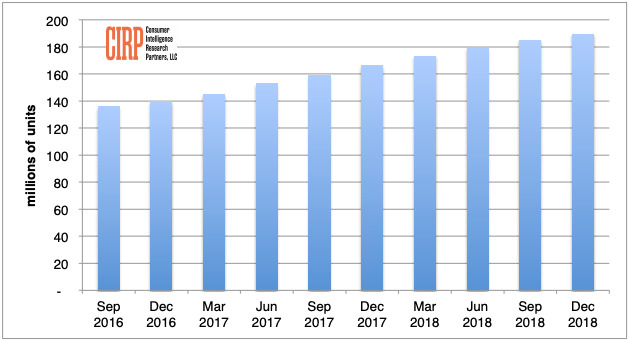The audience for iPhone is continuing to grow in the United States, albeit at a slower rate, research suggests, with the install base for Apple's smartphone reaching 189 million units in the last quarter of 2018, an increase of 23 million on the same quarter in 2017.
While there are reports of lower than anticipated sales of the iPhone, research seems to indicate that it isn't as much of an issue relating to US-based sales, according to Consumer Intelligence Research Partners (CIRP), in a report provided to AppleInsider.
It is claimed the United States' install base of iPhones at the end of December is up just 4 million from the end of September 2018, when CIRP believes the base is 185 million iPhones. For the December quarter in 2017, CIRP believes the install base was 166 million units, which works out that the latest quarter saw a year-on-year increase of 13.9 percent.
CIRP notes the increase is a reduction in growth compared to the 19 percent year-on-year increase saw last year. The 2 percent sequential quarterly growth is also lower than observed last year, which saw a 5 percent gain over the prior quarter.
"With slowing iPhone sales, the installed base of iPhones in use in the US grow only slightly in the quarter," advised CIRP partner and co-founder Josh Lowitz. "As Apple itself indicated, iPhone revenues declined relative to last year, driven primarily by reduced demand in overseas markets. US sales remain relatively stable, which shows up in slight growth in the US installed base."
In the January earnings announcement, Apple advised of a 15-percent year-on-year drop in iPhone revenue, which contributed to overall revenue of $84.3 billion missing initial forecasts of between $89 billion and $93 billion.
CIRP notes the longer replacement cycles likely to have caused some of the reduction in the US install base growth, suggesting it is "primarily driven by first-time smartphone buyers and the limited number of platform switchers from Android to iOS."
CIRP's report also takes a stab at attempting to answer the question of how many units Apple shipped in the quarter, a figure no longer disclosed by the company following a change in policy to not provide units figures in every results release.
"We use our weighted average retail price for the US, called US-WARP, as a close approximation of ASP (average selling price)" states partner and cofounder Mike Levin. "Based on an estimated ASP of $839 and Apple's disclosed iPhone revenues of about $52 billion, we estimate Apple sold approximately 62 million iPhones, of all models and storage capacities, globally in the quarter."
The analysts then translated this estimated figure for global shipments into its estimates for US unit sales.
The main cause of Apple's reduced iPhone shipments is not the United States, but another major market. In his January warning to investors ahead of the results, Apple CEO Tim Cook cited lower revenue "primarily in Greater China" accounting for the revenue shortfall.
To counter the slowing sales for the market, Apple started to slash the prices of its products in China in an attempt to boost sales, a tactic that seems to be having some success.
 Malcolm Owen
Malcolm Owen






-m.jpg)






 Charles Martin
Charles Martin


 Wesley Hilliard
Wesley Hilliard
 Stephen Silver
Stephen Silver
 William Gallagher
William Gallagher

 Marko Zivkovic
Marko Zivkovic









7 Comments
The growth scale looks identical to the same time period in 2016, no? Dec 16-Mar 17 as well. What does the data say?
If the iPhone has an install base of 185 million in the U.S., a nation with a population of something like 330 million, that's incredible. I'm not sure I buy that, but I wouldn't say it's not possible.
That said, yeah, it isn't in the U.S. where Apple struggled (to the extent it's fair to say that it did) with iPhone sales in this past quarter. Even with a smaller iPhone ASP, Apple reported YoY revenue growth in the Americas of 5%. A lot of that came from other products and services, and iPhone revenue might have actually dropped (in the Americas) a little bit. But iPhone units (in the Americas) likely either grew a small amount or only declined a small amount. For that not to be the case, other products and services would have to have grown at a much higher rate in the Americas than in the rest of the world.